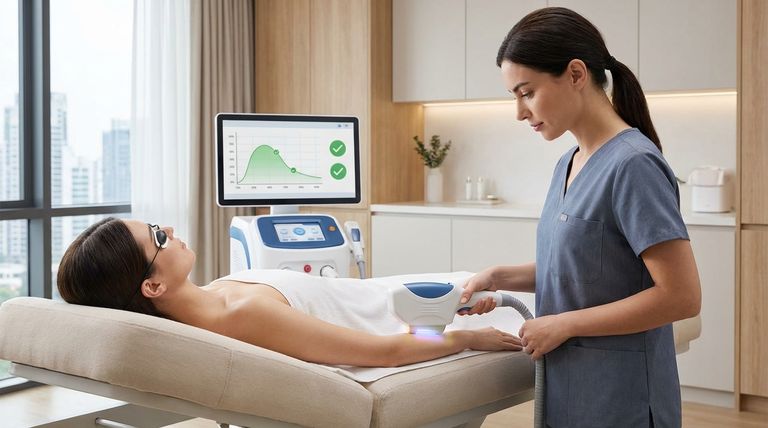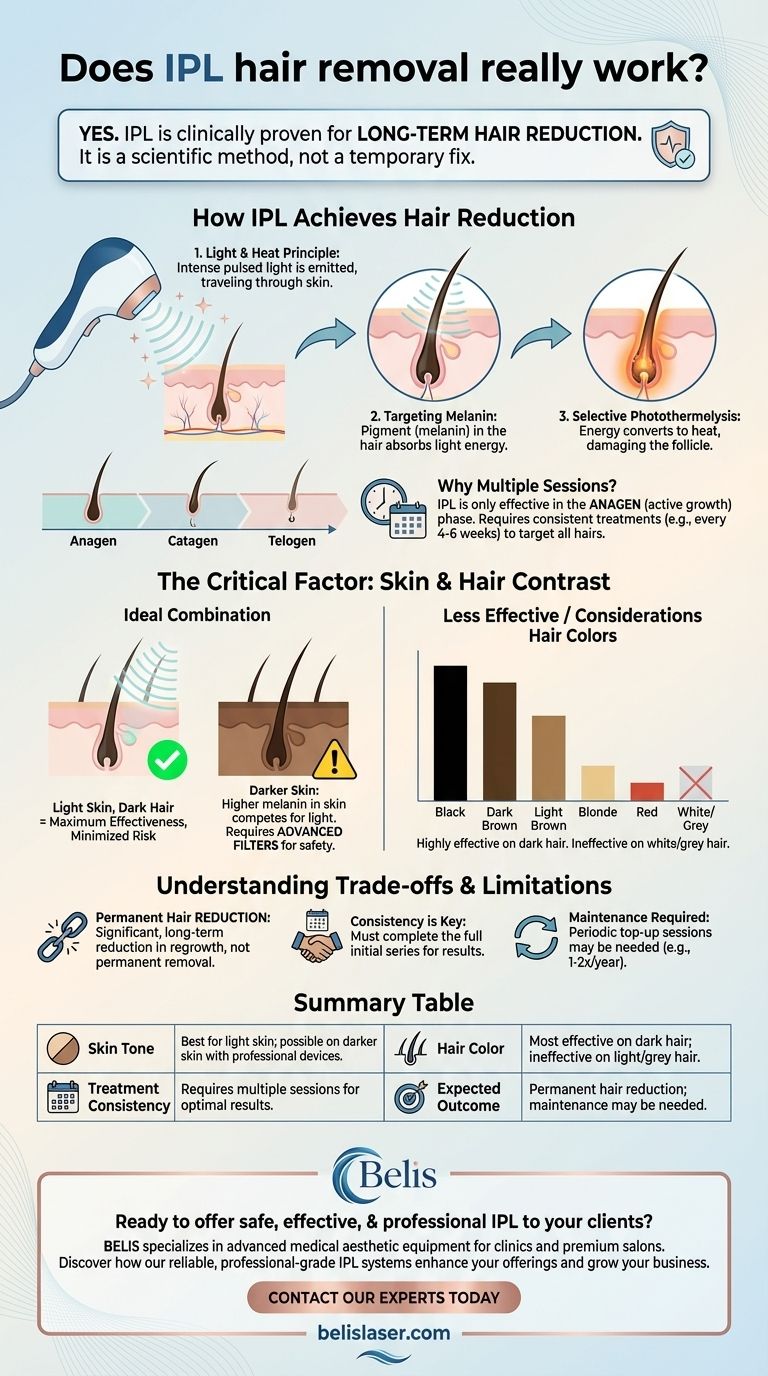Yes, Intense Pulsed Light (IPL) is a clinically proven and effective method for long-term hair reduction. It is not a temporary solution like shaving or waxing, but a technology that uses light to target and damage the hair follicle, significantly reducing its ability to regrow hair over time. Studies have repeatedly demonstrated that IPL is a legitimate and useful light source for achieving this result.
IPL is a valid scientific method for significantly reducing unwanted hair, not a gimmick. However, its success is fundamentally dependent on the contrast between your skin tone and hair color, and it requires multiple, consistent treatments to achieve and maintain results.

How IPL Achieves Hair Reduction
To understand if IPL will work for you, you first need to understand the mechanism behind it. The technology isn't magic; it's a targeted application of physics.
The Principle of Light and Heat
IPL devices emit a broad spectrum of intense, pulsing light. This light energy travels through the skin and is absorbed by pigment.
When the pigment absorbs the light, the energy is converted into heat. This targeted heat is what damages the hair follicle, a process known as selective photothermolysis.
Targeting Melanin in the Hair
The specific pigment IPL targets is melanin, which is responsible for giving color to our hair and skin.
The goal is for the melanin within the hair shaft to absorb the light energy, heat up, and damage the key structures of the follicle responsible for hair growth.
Why Multiple Sessions Are Necessary
Your hair grows in cycles (anagen, catagen, telogen). IPL is only effective when the hair is in its active growth phase, the anagen phase.
At any given time, only a fraction of your hair is in this phase. This is why you need a series of treatments, typically spaced 4-6 weeks apart, to catch each hair as it enters its active growth window.
The Critical Factor: Skin and Hair Contrast
The effectiveness of IPL is not universal; it is dictated by the amount of melanin in your hair versus the amount in your skin. The system works best when there is a clear contrast.
The Ideal Combination
The ideal candidate for IPL has light skin (low melanin) and dark hair (high melanin).
This combination allows the light energy to pass safely through the skin and be absorbed almost exclusively by the hair follicle, maximizing effectiveness and minimizing risk.
Effectiveness on Different Hair Colors
Because IPL targets melanin, it is highly effective on black and dark brown hair.
It is significantly less effective on light brown, blonde, and red hair. It is completely ineffective on white or grey hair, as these hairs contain no melanin for the light to target.
Considerations for Darker Skin Tones
Treating darker skin tones with IPL is more complex. The higher level of melanin in the skin can also absorb the light energy, competing with the hair follicle.
This can lead to a higher risk of side effects like burns or pigmentation changes. However, as clinical results show, modern professional IPL devices can use specialized cut-off filters to target the hair more precisely and make treatment safe and successful for a wider range of skin types.
Understanding the Trade-offs and Limitations
Setting realistic expectations is crucial for being satisfied with your IPL results. It's important to understand what the technology can and cannot do.
It's Hair Reduction, Not Permanent Removal
The FDA-approved terminology is "permanent hair reduction," not "permanent hair removal."
This means you should expect a significant, long-term reduction in the number of hairs that regrow. It does not mean every single hair will be gone forever.
Consistency is Key
You must complete the full series of initial treatments as recommended by the device manufacturer or your practitioner. Skipping or delaying sessions will compromise your final results.
Maintenance Is Often Required
After your initial course of treatments, you will likely need periodic maintenance sessions, perhaps once or twice a year.
Hormonal changes or dormant follicles becoming active can cause new hair to grow, which can be managed with these top-up treatments.
Is IPL the Right Choice for You?
To make a final decision, evaluate your goals against the capabilities of the technology.
- If you have light skin and dark hair: You are the ideal candidate for IPL and can expect significant, long-term hair reduction with consistent treatment.
- If you have dark skin and dark hair: Professional IPL with advanced filters can be very effective, but you must seek a qualified practitioner to ensure a safe and successful outcome.
- If you have blonde, red, grey, or white hair: IPL is unlikely to work for you, and you should investigate alternative methods like electrolysis for permanent removal.
By understanding the science, you can accurately determine if IPL technology aligns with your specific needs and goals for hair reduction.
Summary Table:
| Factor | Impact on IPL Effectiveness |
|---|---|
| Skin Tone | Best for light skin; possible on darker skin with professional devices. |
| Hair Color | Most effective on dark hair (black/brown); ineffective on light/grey hair. |
| Treatment Consistency | Requires multiple sessions (4-6 weeks apart) for optimal results. |
| Expected Outcome | Permanent hair reduction, not complete removal; maintenance may be needed. |
Ready to offer safe, effective, and professional IPL hair removal services to your clients?
BELIS specializes in advanced medical aesthetic equipment, providing clinics and premium beauty salons with reliable, professional-grade IPL systems designed for optimal results and client safety across various skin types.
Contact our experts today to discover how our technology can enhance your service offerings and grow your business.
Visual Guide

Related Products
- IPL SHR Hair Removal Machine for Permanent Hair Removal
- Clinic Use IPL and SHR Hair Removal Machine with Nd Yag Laser Tattoo Removal
- Clinic Use IPL SHR ND YAG Laser Hair Removal RF Skin Tightening Machine
- IPL SHR+Radio frecuency machine
- Diode Tri Laser Hair Removal Machine for Clinic Use
People Also Ask
- How quickly do you see IPL results? A Realistic Timeline for Clearer Skin
- What are the negative effects of IPL? Understanding Risks for Safe Treatment
- Does IPL hair removal actually work? Achieve Long-Term Hair Reduction
- What should I look for in an IPL machine? Key Features for Effective Hair Removal
- Can you use hair removal device on private parts? A Guide to Safe Bikini Area IPL



















